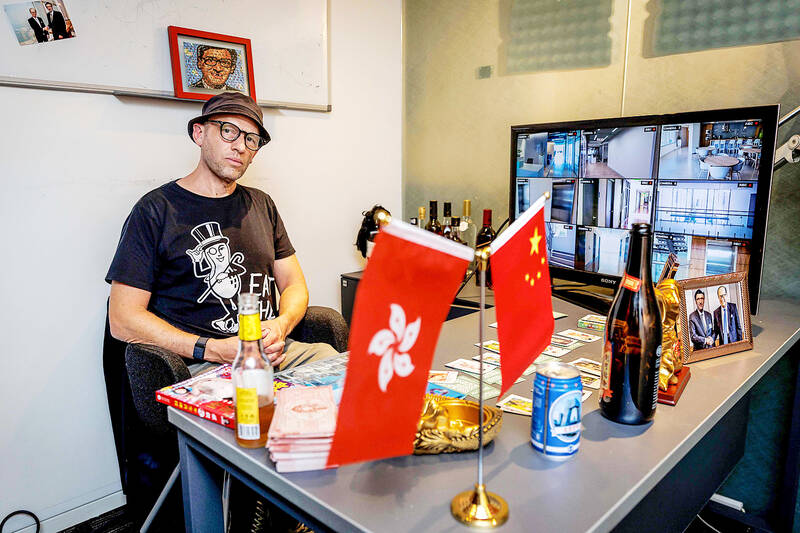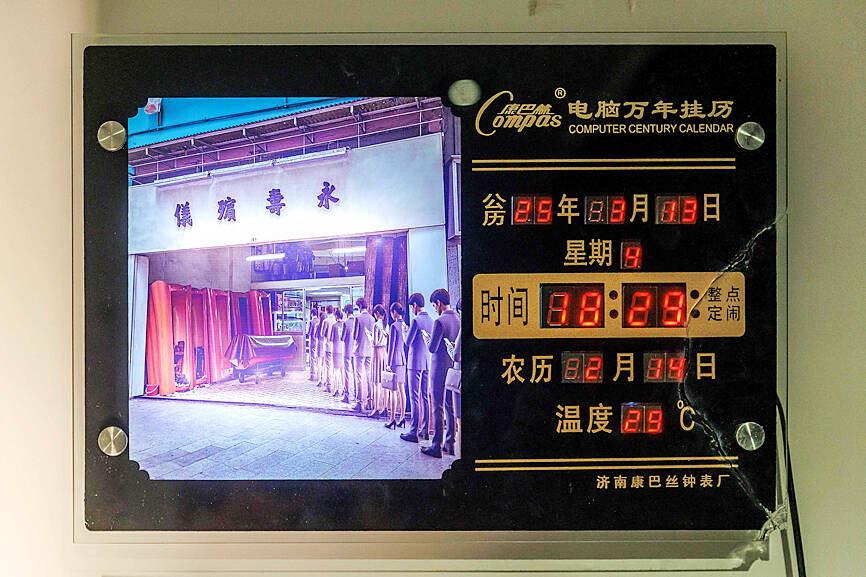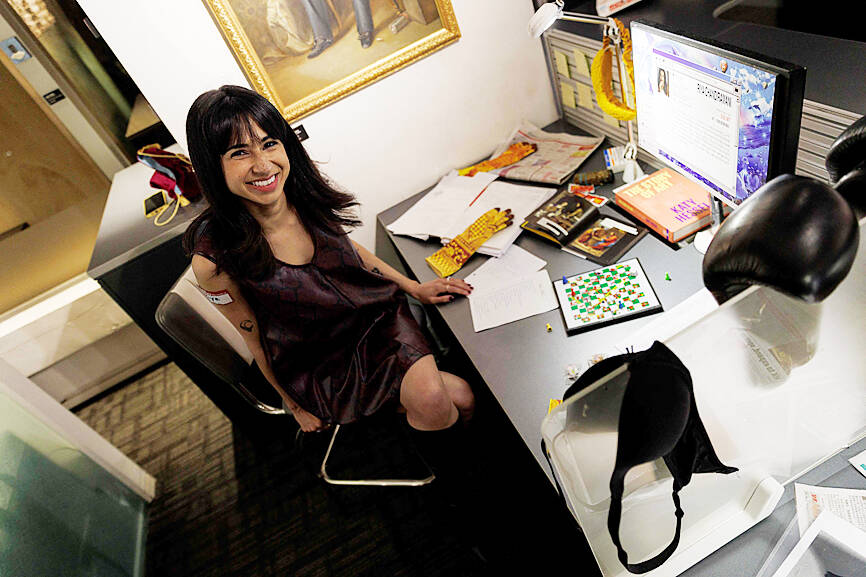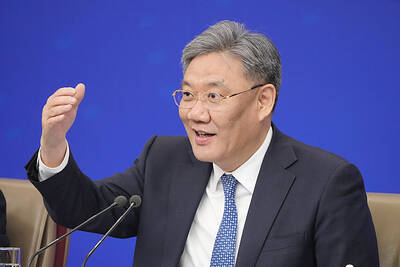At first glance, the office desk could belong to any Chinese executive — an ashtray, mini-flags, a golden sculpture inscribed with the character for “integrity” and a picture of a local celebrity.
Instead, it is part of a defiant art show challenging Hong Kong’s stuffy power structures, held in an office tower at the heart of a finance district famous for its long hours and cut-throat competition.
The group exhibition — named “RE:Urgent” in mockery of corporate-speak — is meant to “subvert the office space that we are working in every day,” said curator Renee Lui, managing director of Young Soy Gallery.

Photo: AFP
The exhibition mirrors a workspace, with four artists given a standard office cubicle to present their work in, and one displaying in the boss’ office. “This is sort of a really rigid space that people (wouldn’t normally) see as being able to contain creative ideas,” Lui said.
The main office is occupied by artist Dominic Johnson-Hill, whose idiosyncratic desktop was inspired by his 28 years doing business in Beijing.
“I went to a lot of bosses’ offices,” he said. “I really wanted to sort of copy a lot of that paraphernalia.”

Photo: AFP
His displayed pieces include a surreal digital wall clock, which tells time in an eerie, robotic voice. Next to its numbers is a picture of people looking down at their phones whilst queuing to enter a coffin store.
Johnson-Hill came across such traditional shops in a Hong Kong neighborhood and was inspired to create the piece, which he said poked fun at aimless work culture.
“I thought how wonderful it would be to see people dressed in office attire queuing... [it is] a ridiculous idea that was quite playful,” he said.

Photo: AFP
In another cubicle, artist Riya Chandiramani sits role-playing as an “unpaid intern” who dreams of starting a feminist revolution. In a painting, she imagines herself as the Hindu goddess, Kali, forced into a treacherous game of snakes and ladders set in the workplace.
“The numbers also represent ages, and so there is also that aspect of women not being allowed to age,” Chandiramani said.
The show is taking place during Hong Kong’s “Art Month,” headlined by art fairs that draw wealthy buyers from around the world.

Photo: AFP
However, gallery co-founder Shivang Jhunjhnuwala said he decided to ditch the fairs after two years because of high exhibition costs and “a lack of confidence in the art market.”
The show is pushing against the mainstream in its thematic matter too. In one corner, almost unnoticed, is a palm-sized paper cutout of Chinese President Xi Jinping (習近平), trapped within multiple frames, by pseudonymous artist Louie Jaubere. “The people are not in control of what the state dictates,” the artist said, “but it is not targeted at China; it generally represents government or state control.”
Hong Kong’s freedom of expression and political rights have been whittled away since Beijing imposed a sweeping national security law in 2020 after large and sometimes violent protests the year before. At the show’s opening, retired architect Serena Chan said she appreciated the show’s sense of humor.
“The other rebels are all gone,” she said. “Rebels in art are probably still allowed, so let’s have more of that.”

‘EYE FOR AN EYE’: Two of the men were shot by a male relative of the victims, whose families turned down the opportunity to offer them amnesty, the Supreme Court said Four men were yesterday publicly executed in Afghanistan, the Supreme Court said, the highest number of executions to be carried out in one day since the Taliban’s return to power. The executions in three separate provinces brought to 10 the number of men publicly put to death since 2021, according to an Agence France-Presse tally. Public executions were common during the Taliban’s first rule from 1996 to 2001, with most of them carried out publicly in sports stadiums. Two men were shot around six or seven times by a male relative of the victims in front of spectators in Qala-i-Naw, the center

Canadian Prime Minister Mark Carney is leaning into his banking background as his country fights a trade war with the US, but his financial ties have also made him a target for conspiracy theories. Incorporating tropes familiar to followers of the far-right QAnon movement, conspiratorial social media posts about the Liberal leader have surged ahead of the country’s April 28 election. Posts range from false claims he recited a “satanic chant” at a campaign event to artificial intelligence (AI)-generated images of him in a pool with convicted sex offender Jeffrey Epstein. “He’s the ideal person to be targeted here, for sure, due to

DISPUTE: Beijing seeks global support against Trump’s tariffs, but many governments remain hesitant to align, including India, ASEAN countries and Australia China is reaching out to other nations as the US layers on more tariffs, in what appears to be an attempt by Beijing to form a united front to compel Washington to retreat. Days into the effort, it is meeting only partial success from countries unwilling to ally with the main target of US President Donald Trump’s trade war. Facing the cratering of global markets, Trump on Wednesday backed off his tariffs on most nations for 90 days, saying countries were lining up to negotiate more favorable conditions. China has refused to seek talks, saying the US was insincere and that it

Australia’s opposition party yesterday withdrew election promises to prevent public servants from working from home and to slash more than one in five federal public-sector jobs. Opposition leader Peter Dutton announced his conservative Liberal Party had dropped its pledge that public servants would be required to work in their offices five days a week except in exceptional circumstances. “I think we made a mistake in relation to this policy,” Dutton told Nine Network television. “I think it’s important that we say that and recognize it, and our intention was to make sure that where taxpayers are working hard and their money is